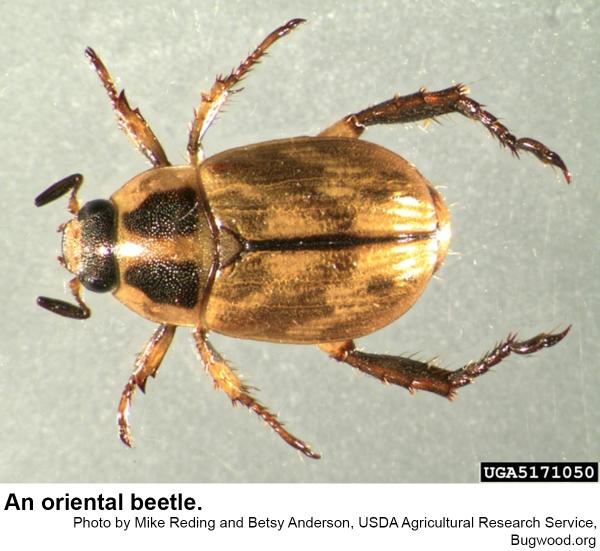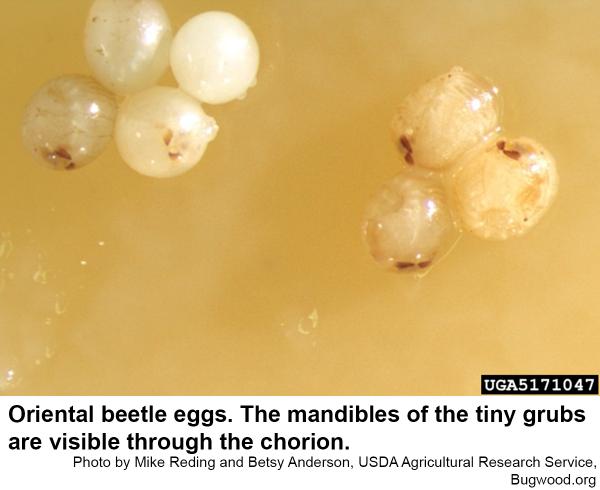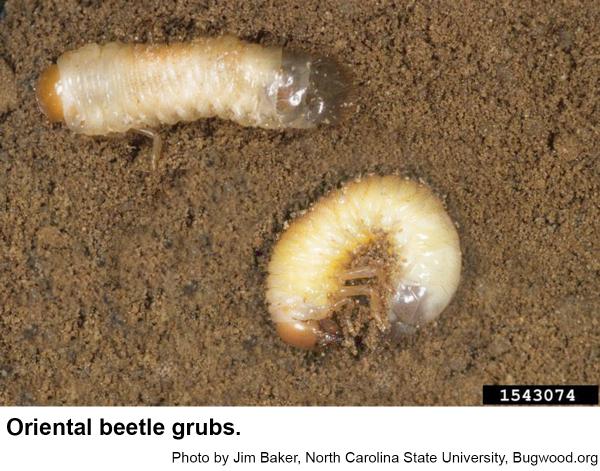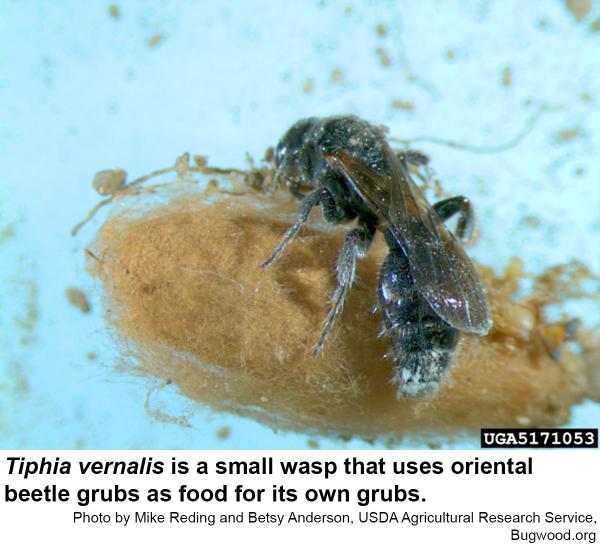Description and Biology
Oriental beetles, Anomala orientalis, are about ½ inch long and are oval in top view. They range in color from solid black to mottled black and brown, to almost completely unmarked pale brown. The eggs are small and spherical. Oriental beetle grubs are almost identical to those of Japanese beetles, that is, C-shaped white grubs that grow to almost ¾ inch long. However they can be distinguished by parallel rows of setae on the raster visible only with a hand lens. Adults begin to emerge mid June (shortly before Japanese beetles emerge) and may continue to emerge into September. They feed and mate after emergence. After mating, females burrow 2 to 4 inches into the soil and lay eggs. Females enter the soil several times and lay several eggs each time. Females prefer well watered soils, but dryer sites are also infested. Eggs cannot develop in extremely dry soil. This beetle flies in the evening with peak activity between 7:00 and 11:00 PM (maximum around 9:00). The majority of adult emergence takes place in July. By late July, grubs have hatched and actively feed on fine rootlets of turfgrasses as well as dead organic matter in the top 2 inches of the soil profile. Grubs molt twice as they grow during the summer. As soils cool in the fall, the grubs dig down further to spend the winter. As soils warm the following spring, the grubs ascend to feed for 4 or 5 weeks. Grubs then tunnel downward to pupate in a cell. Sometime later, a new generation of adult beetles emerges from the soil to continue their wheel of existence.
Host Plants
Adults usually cause minor damage to most flowering plants, and are particularly attracted to daisies, roses, hollyhock, phlox, and petunias. Grubs sometimes seriously damage roots of annual and perennial grasses as well as fully grown nursery stock (even containerized plants).
Residential Recommendations
Some biological suppression of oriental beetles is given by the spring typhia, Tiphia vernalis, a small, black wasp that digs down to oriental beetle grubs and lays its eggs on the grub. The spring typhia egg hatches and the wasp grub eventually consumes the oriental beetle grub. The spring typhia grub then spins a cocoon in which it spends the winter, pupates the following spring, and a new generation of wasps emerges later. Tiphiid wasps are harmless to humans unless a female is handled carelessly or stepped on.
It is not a good idea to spray flowers to protect them from oriental beetles, Japanese beetles, or any other chewing pests as pollinators and butterflies are bound to suffer from the pesticide residue. Suspending a light bulb over a pan of soapy water each evening helps catch many oriental beetles as they fly about. Place the pan on the ground with the light bulb a few inches above it. To control oriental beetle grubs, apply an insecticide labeled for turf pest control in home landscapes. Fortunately, oriental beetles are not thought to be resistant to pesticides. The garden supply sections of most big box stores have several pesticides available.
References
- Increased field and greenhouse efficacy against scarab grubs with a combination of an entomopathogenic nematode and Bacillus thuringiensis. Koppenhöfer, A. M. et al. 1999. Biological Control 14 (1): 37-44
- The Oriental Beetle. Aim, S. R. 1996. TurfGrass TRENDS July 1996. Pp. 9 - 13.
- Extension Plant Pathology Publications and Factsheets
- Horticultural Science Publications
- North Carolina Agricultural Chemicals Manual
For assistance with a specific problem, contact your local N.C. Cooperative Extension Center.
This Factsheet has not been peer reviewed.
Publication date: Aug. 2, 2016
Reviewed/Revised: May 11, 2021
Recommendations for the use of agricultural chemicals are included in this publication as a convenience to the reader. The use of brand names and any mention or listing of commercial products or services in this publication does not imply endorsement by NC State University or N.C. A&T State University nor discrimination against similar products or services not mentioned. Individuals who use agricultural chemicals are responsible for ensuring that the intended use complies with current regulations and conforms to the product label. Be sure to obtain current information about usage regulations and examine a current product label before applying any chemical. For assistance, contact your local N.C. Cooperative Extension county center.
N.C. Cooperative Extension prohibits discrimination and harassment regardless of age, color, disability, family and marital status, gender identity, national origin, political beliefs, race, religion, sex (including pregnancy), sexual orientation and veteran status.




